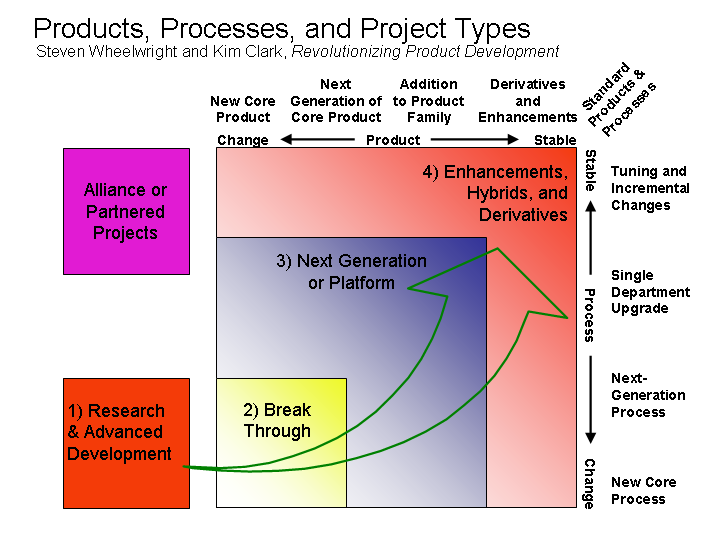Development Project Types
From Steven Wheelwright and Kim Clark, Revolutionizing Product Development
Introduction
Perhaps no activity in business is more heralded for its promise and approached with more justified optimism than new-product and new-process development. The anticipated benefits almost defy description. The potential benefits are of three types: market position, resource utilization, and organizational renewal and enhancement. In terms of market position, ideally a new product can set industry standards or open up whole new markets. Anticipated benefits in resource utilization include on capitalizing on prior R&D investment, improving return on existing assets, applying new technologies, and eliminating or overcoming past weaknesses.
Perhaps the most exciting type of development benefits is the prospect of renewal and transformation of the organization. The excitement, image, and growth associated with product and process development efforts capture the commitment, innovation, and creativity of the entire organization. This success, in turn, enhances the firm's ability to recruit the best people, improve their integration, and accelerate the pace of change. Furthermore, development projects themselves are the vehicle by which new approaches and new thinking are adopted and take on institutional reality.
Unfortunately, in most firms this promise is seldom fully realized�.Wheelwright and Clark propose that product (and process) development strategies can be used to support organizational change efforts. In order for this to happen, the organizational priorities must be known and an aggregate product / process development plan must be written. Classifying projects may facilitate understanding of their relationship to the overall strategy and to one another.
The Figure below shows families of development projects that are determined by 1) the degree of product change increasing to the left and 2) the degree of process change increasing towards the bottom. The green arrow shows the path that ideas take from R&D through Breakthrough Projects towards standard products and processes in the upper right hand corner of the picture. Characteristics of each family are described below.
Enhancements, Hybrids or Derivative Projects
These projects are sustaining projects aimed at improving an existing product or process for known customers. They involve changes to existing products or processes but usually not both. These projects usually require fewer resources than projects that break new ground.
Platform or Next-Generation Projects
These projects involve significant change in either processes, or products, or both. More importantly, they provide a base for a product and process family that can be leveraged over several years. They require more resources than derivatives. These are beach head projects that need to focus on the total service picture. Platform projects must establish a product and a process with three essential characteristics:
- Core performance capabilities that match primary needs.
- Support of an entire product/process generation. The platforms can be expanded and enhanced through the addition or removal of features, thus creating a product family. The platforms must be adaptable and expandable. This is achieved through the architecture of the platform.
- A link to previous and future generations. Platforms provide migration paths for customers.
Breakthrough Projects
These projects establish new core products and new core processes. They may create a whole new product category for a business. Many times these projects focus on products, but they also involve significant process development, indeed, the process is likely to be critical to the success of the project.
Research and Advanced Development Projects
The focus of research and development is the creation of knowledge � know-how and know-why � as a precursor to inclusion in mainline processes or products. Typically R&D is conducted in a separate group staffed with a separate set of people.
Alliance or Partnered Projects
Any type of project can be approached using partnerships, but this introduces considerable complexity and difficulties. It also requires different management approaches and significant leadership that many people do not have much experience with.
